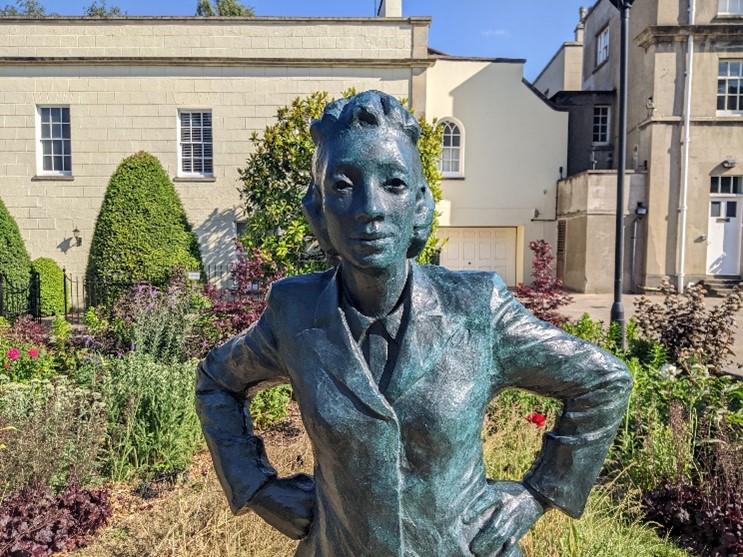Blog by Taylor Riley
Bristol, UK is a monument to the intertwining of histories of slavery and medicine. Smaller, literal monuments around the city tell its stories. There is the plinth that once held the statue of slave trader Edward Colston, which Black Lives Matter protestors toppled and drowned in the harbor in 2020. The bridge named for Pero Jones, enslaved by Bristol sugar merchant John Pretor Pinney, crosses the water to Queens Square, where merchants like Pinney once lived. And then there is the statue of Henrietta Lacks, a bronze figure posed in a broad stance, hands on hips and leaning forward, as if asking a question.

Lacks’s statue stands in Royal Fort Gardens among several university science buildings. It was commissioned by the university and created by Helen Wilson-Roe. Members of Lacks’s family came to its unveiling in 2021. In 2023, Mojisola Adebayo’s play Family Tree ran at Bristol’s Tobacco Factory for the last leg of its national tour. Directed by Matthew Xia, Family Tree breathes new life into Lacks’s story, exploring it through the lens of her immortality and bringing Lacks into dialogue with other untold medical narratives: the enslaved girls and women mutilated by J. Marion Sims in the US, and the National Health Service nurses of color who died of Covid-19 in the UK.
Today, Lacks’s cells (or HeLa cells) remain available to purchase, and in all likelihood, will proliferate for thousands of years. In addition to HeLa being the preeminent cell line used globally in medical research, Bristol researchers publish an average of one scientific paper a month on research using HeLa cells.2 They have revolutionized cancer treatment, led to the creation of IVF, and been pivotal to vaccines from polio to Covid-19. They have also contributed to research generating millions of pounds for the university and the scholars who work there. A local ad for the play shows actor Aminata Francis, who plays Lacks, arm in arm with the statue, along with former Lord Mayor of Bristol, Cleo Lake. A comment on the post reads, “I’ve used her cell line …”
The play’s venue also holds significance. A former Imperial Tobacco company building, the Tobacco Factory theatre is entrenched in histories of slavery, a fitting setting for a play about Lacks, a Virginia tobacco farmer descended from slaves. In 1786, Henry Overton Wills I and partners started a tobacco company, and one of its subsidiaries’ factories was located in the building that is now the theatre, hence its name. The University of Bristol’s first chancellor, Henry Overton Wills III, used slave-produced tobacco from the US for the business until slavery was abolished there in 1865. This “allowed the family to become the great philanthropists for which they are now remembered.”2
As the lights dim low in the theatre, Francis comes to the stage, not yet having “become” Lacks, reciting a spoken word poem that serves as the play’s prologue. It mixes metaphors of land and body, human cells and prison cells. “I am repeating myself,” she says. She then transforms into Lacks with the words “myself is repeating,” a change in syntax that signals the plays theme—Lacks is embodied many times over. That process of repetition echoes throughout the play, reminding audiences of Lacks’s unique mode of being. In the first scene, Lacks finds herself in limbo shortly after her death from cervical cancer, playfully and devastatingly cycling between past and present on the dark and ethereal set. She mourns her family, she ponders mobile phones, and she asks questions of the audience, repeating herself to get answers. Later in the play, actor Mofetoluwa Akande becomes the orisha Oshun—deity of oceans traversed throughout the slave trade, those encased in human bodies and within cell walls, and sexual fluids and blood. And as Lacks herself becomes the orisha HeLa, the family tree onstage—beneath which she has toiled and mourned—lights up. Its twisting trunk branches out and reveals its shape as a helix, a tree of DNA that lives forever.
Orishas travelled with enslaved peoples across the Atlantic and took root in healing practices. Solimar Otero discusses how these Yoruba deities “become active agents in the world through rituals, archives, and the creation of material culture.”3 Lacks’s transformation into an orisha is a call to witness and revere her material immortality, but also to understand the body as a representation that replicates through medical violence—violence extending from that committed by Sims, to Lacks’s treatment before and after her death at Johns Hopkins, to racialized health disparities, to the erasure of the medical knowledge of enslaved peoples that black anthropologists like Zora Neale Hurston and Maya Deren have written about.
To return to the statue of Lacks, it is impossible to capture the essence of a deity in bronze, impossible for researchers to erase violence through good faith or gratitude. Bristol will soon house a new monument to honor the victims of the transatlantic slave trade. Still, valorizations of slavery remain here, like the memorials of slave traders and profiteers in Bristol Cathedral. Henrietta Lacks will never die, though the violence of the world she departed from must, if we are to fully realize her immortal legacy.
References
[1] “More Than a Cell: The Legacy of Henrietta Lacks,” Research, University of Bristol, accessed March 18, 2024, https://www.bristol.ac.uk/research/impact/stories/hela-cells/. Comment attributed to Harry Mellor, Professor of Biochemistry at the University of Bristol.
[2] Caine Tayo Lewin-Turner, “Blood on the Bricks: More than Colston?” Bristol Museums Collections (blog), accessed March 18, 2024, https://collections.bristolmuseums.org.uk/stories/transatlantic-traffic-enslaved-africans/blood-on-the-bricks-more-than-colston.
[3] Archives of Conjure: Stories of the Dead in Afrolatinx Cultures (New York: Columbia University Press, 2020), 3.
Taylor Riley is a Postdoctoral Research Fellow in anthropology at University College London, working as part of a multinational project on biosocial birth cohort research. She is interested in intersecting oppressions within histories of medicine, feminist science, and technology studies, and queer and trans bodies and life courses.